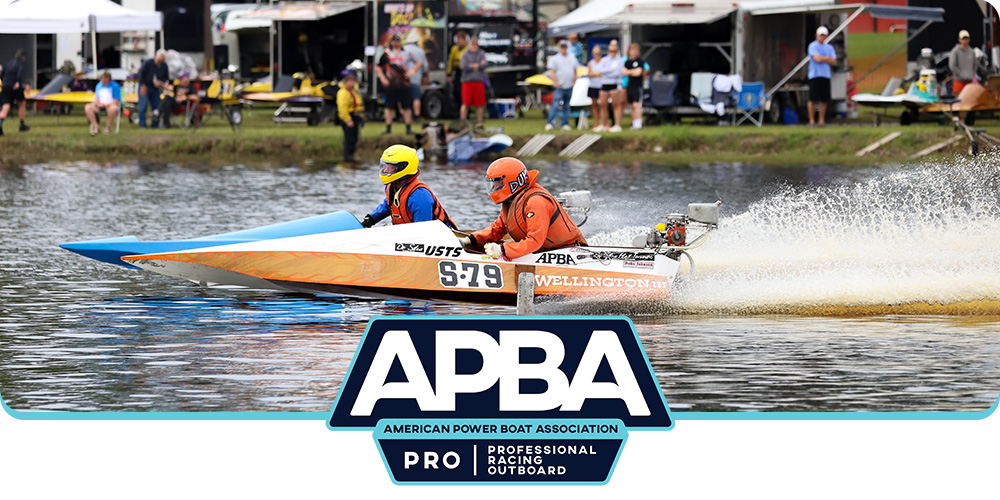
Professional Racing Outboard (PRO) is the most diverse and electrifying category the APBA has to offer. With 19 classes, PRO boats speeds range from moderate to blazing fast, old tech to cutting edge tech and cost ranges from extremely affordable to substantial investments. Looking for power? Completion engines in the PRO category can run at upwards of 13,000 RPMs – compare that to a typical stock race car that runs at 7,000 RPMs and you’ll understand why we think water beats pavement any day.
How do you choose the best class for you? PRO Boats are roughly 9 to 14 feet long and weigh 100 to 250 pounds. Most are made of wood; but carbon fiber, honeycomb and other high-tech materials are also used. Most drivers kneel in the cockpit; some boats are driven in a lay-down position; some have the driver seated. Typically the left hand works the spring-loaded throttle and the right hand handles the steering wheel.
The boats are of two distinct designs-Hydros and Runabouts.
Hydros ride on a cushion of air; the boat contacts the water’s surface on two sponsons (projections) and the propeller. The design is generally unrestricted, challenging those who wish to experiment in boat design and construction.
Runabouts have certain restrictions, like minimum lengths. While there is great variety in runabout design, generally they have a flat riding surface, tapered to a point in front, and do not channel air under the hull. While, typically slower than Hydros, the thrills of racing runabouts are unmatched, just watch a runabout round a buoy and you’ll see the difference!
Thirteen of the PRO classes are based primarily on motor displacement. They are sometimes referred to as “bore and stroke” classes. The maximum displacements of bore and stroke classes are 125cc (128.75cc), 175cc, 250cc (257.5cc), 350cc, 500cc, 700cc, and 1100cc (1133cc). There are no minimum weights in these classes, and in the hydro classes, there are few restrictions on hulls. The three largest hydro classes, 500ccH, 700ccH, and 1100ccH must utilize a reinforced cockpit (capsule) with the driver seated. The 125cc classes must use one cylinder motors. The 1100cc Runabout must carry two persons, a driver and a “rider”. Most bore and stroke classes utilize a fuel based on methanol and oil.
The K PRO Hydro class is a class for kids only. The OSY400 class is the USA version of the largest UIM powerboat racing class in the world. K PRO Hydro and OSY400 are restricted to gasoline and oil fuel. The C Service and C Racing classes are based on American built fishing and racing motors from the 1930s to the 1950s.
 Boats competing in the 1100ccH class must utilize a reinforced cockpit with approved driver restraints. Additionally, the 1100ccH class has the following displacement ranges for 2-stroke and 4-stroke motors: 2-Stroke: (Min. cc’s = Over 350 Max cc’s =1,133) 4 Stroke: (Min. cc’s = Over 525 Max cc’s = 1,699.5)
Boats competing in the 1100ccH class must utilize a reinforced cockpit with approved driver restraints. Additionally, the 1100ccH class has the following displacement ranges for 2-stroke and 4-stroke motors: 2-Stroke: (Min. cc’s = Over 350 Max cc’s =1,133) 4 Stroke: (Min. cc’s = Over 525 Max cc’s = 1,699.5)
| Minimum Length: | |
| Minimum Weight: | |
| Engine: | Any motor over 350cc up to and including 1133cc |
| Fuel: | |
| Approximate Speed: | over 90mph |
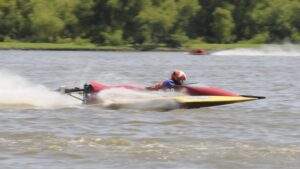 1100CC Runabout Specifications
1100CC Runabout Specifications| Minimum Length: | 13′ |
| Minimum Weight: | |
| Engine: | Any motor over 500cc up to and including 1133cc |
| Fuel: | |
| Approximate Speed: | 90 mph |
 125CC Hydro Specifications
125CC Hydro Specifications| Minimum Length: | |
| Minimum Weight: | |
| Engine: | Any single-cylinder motor up to and including 128.75cc |
| Fuel: | |
| Approximate Speed: | 70+mph |
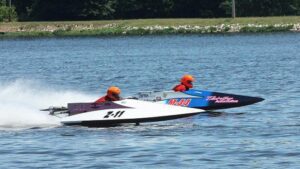 The 125cc Runabout class was first introduced to the APBA mid-season during 2002. These single-cylinder two-stroke engines scream, turning upwards of 14,000 rpms and pushing speeds of 80 MPH – compare that to a NASCAR motor, which tops out at a regulated 9,000 RPM.
The 125cc Runabout class was first introduced to the APBA mid-season during 2002. These single-cylinder two-stroke engines scream, turning upwards of 14,000 rpms and pushing speeds of 80 MPH – compare that to a NASCAR motor, which tops out at a regulated 9,000 RPM.
| Minimum Length: | 11′ 6″ |
| Minimum Weight: | |
| Engine: | Any single-cylinder motor up to and including 128.75cc |
| Fuel: | Any non-pressurized liquid fuel is permitted |
| Approximate Speed: | 60+mph |
 175CC Hydro Specifications
175CC Hydro Specifications| Minimum Length: | |
| Minimum Weight: | |
| Engine: | Any motor up to and including 175cc |
| Fuel: | Any non-pressurized liquid fuel is permitted |
| Approximate Speed: | 60+mph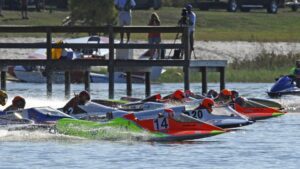 |
 250CC Runabout Specifications
250CC Runabout Specifications| Minimum Length: | 11′ 6″ |
| Minimum Weight: | |
| Engine: | Any motor over 175cc up to and including 257.5cc |
| Fuel: | |
| Approximate Speed: |
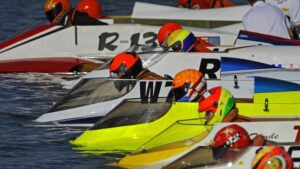 350CC Hydro Specifications
350CC Hydro Specifications| Minimum Length: | |
| Minimum Weight: | |
| Engine: | Any motor over 257.5cc up to and including 350cc |
| Fuel: | |
| Approximate Speed: |
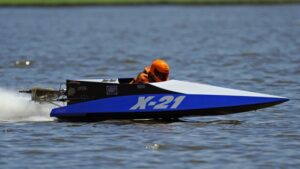 350CC Runabout Specifications
350CC Runabout Specifications| Minimum Length: | 12′ |
| Minimum Weight: | |
| Engine: | Any motor over 257.5cc up to and including 350cc |
| Fuel: | |
| Approximate Speed: |
 500CC Hydro Specifications
500CC Hydro Specifications| Minimum Length: | |
| Minimum Weight: | |
| Engine: | Any motor over 350cc up to and including 500cc |
| Fuel: | |
| Approximate Speed: | 100+mph |
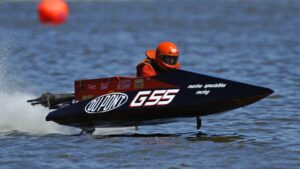 500CC Runabout Specifications
500CC Runabout Specifications| Minimum Length: | 13′ |
| Minimum Weight: | |
| Engine: | Any motor over 350cc up to and including 500cc National Champion |
| Fuel: | |
| Approximate Speed: |
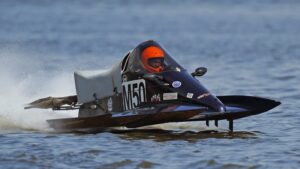 700CC Hydro Specifications
700CC Hydro Specifications| Minimum Length: | |
| Minimum Weight: | |
| Engine: | Any motor over 500cc up to and including 700cc |
| Fuel: | |
| Approximate Speed: |
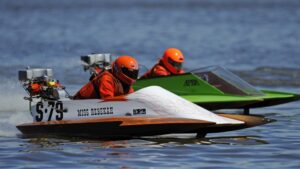 The C Racing Hydroplane (CracH) classes are based on the American-built factory racing outboard motors approved for use in the C Racing classes during the 1930s, 1940s, and 1950s. All approved motors feature 2-cylinder engines with 30 cubic inches of displacement. The C Racing Hydro class has a maximum propeller height limit of 2.25 inches. Propeller height is defined as the maximum distance that the propeller blade may extend above the bottom of the boat.(measured from the true bottom-not measured from any tunnel).
The C Racing Hydroplane (CracH) classes are based on the American-built factory racing outboard motors approved for use in the C Racing classes during the 1930s, 1940s, and 1950s. All approved motors feature 2-cylinder engines with 30 cubic inches of displacement. The C Racing Hydro class has a maximum propeller height limit of 2.25 inches. Propeller height is defined as the maximum distance that the propeller blade may extend above the bottom of the boat.(measured from the true bottom-not measured from any tunnel).
| Minimum Length: | |
| Minimum Weight: | |
| Engine: | Johnson PR, Evinrude Racing C, Hubbell Racing C |
| Fuel: | |
| Approximate Speed: |
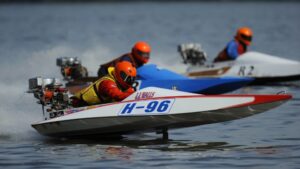 C Racing Runabout Specifications
C Racing Runabout Specifications| Minimum Length: | 13′ |
| Minimum Weight: | 500 lbs. |
| Engine: | Johnson PR, Evinrude Racing C, Hubbell Racing C |
| Fuel: | |
| Approximate Speed: |
 C Service Hydro (CSerH) is based only upon the American-built fishing and pleasure outboard motors listed below and approved for use in the C Service classes during the 1930s, 1940s, and 1950s
C Service Hydro (CSerH) is based only upon the American-built fishing and pleasure outboard motors listed below and approved for use in the C Service classes during the 1930s, 1940s, and 1950s
| Minimum Length: | |
| Minimum Weight: | 450 lbs. |
| Engine: | OMC Speeditwin, Johnson P-50, Johnson PX-50, Johnson PO |
| Fuel: | |
| Approximate Speed: |
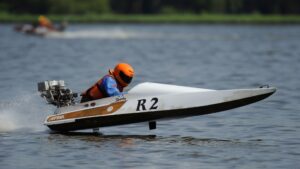 The C Service classes are based only upon the American-built fishing and pleasure outboard motors listed below and approved for use in the C Service classes during the 1930s, 1940s, and 1950s.
The C Service classes are based only upon the American-built fishing and pleasure outboard motors listed below and approved for use in the C Service classes during the 1930s, 1940s, and 1950s.
| Minimum Length: | 13′ |
| Minimum Weight: | 500 lbs. |
| Engine: | OMC Speeditwin, Johnson P-50, Johnson PX-50, Johnson PO |
| Fuel: | |
| Approximate Speed: |
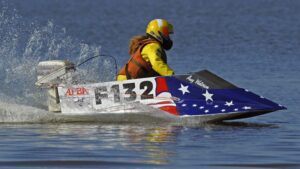 The K PRO Hydro (KPH) Class is the PRO Category’s own spin on the Junior Classes. Allowing aspiring racers to get an early start on the competition, KPH racing is for ages 11-16. As an entry-level class, KPH is the only PRO Hydro class that uses stock outboard motors. The OMC J/A and Mercurcy 15 motors used in the KPH Class are identical to those in the Junior Classes, allowing cross-category participation for kids and more bang for your racing buck!
The K PRO Hydro (KPH) Class is the PRO Category’s own spin on the Junior Classes. Allowing aspiring racers to get an early start on the competition, KPH racing is for ages 11-16. As an entry-level class, KPH is the only PRO Hydro class that uses stock outboard motors. The OMC J/A and Mercurcy 15 motors used in the KPH Class are identical to those in the Junior Classes, allowing cross-category participation for kids and more bang for your racing buck!
| Minimum Length: | |
| Minimum Weight: | |
| Engine: | Mercury 60J, OMC J/A 13.2 cu. in, Merchry J/A15 (15.9 cu. in. produced in 1999 or later) |
| Fuel: | |
| Approximate Speed: |
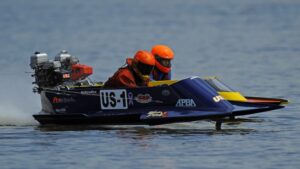 OSY-400 is an international class raced throughout the US and Europe. That makes for big, highly competitive fields vying for World championships, National titles and speed records. The boat must be a hydroplane type, without weight restrictions.
OSY-400 is an international class raced throughout the US and Europe. That makes for big, highly competitive fields vying for World championships, National titles and speed records. The boat must be a hydroplane type, without weight restrictions.
| Minimum Length: | |
| Minimum Weight: | |
| Engine: | Yamato 80, Yamato 102, Yamato 202, Yamato 302 |
| Fuel: | |
| Approximate Speed: |
The K PRO Runabout (KPR) Class is a new to the PRO Category in 2023. Allowing aspiring racers to get an early start on the competition, KPR racing is for ages 11-16. As an entry-level class, KPR is the only PRO PRO runabout class that uses stock outboard motors. The OMC J/A and Mercurcy 15 motors used in the KPR Class are identical to those in the Junior Classes, allowing cross-category participation for kids and more bang for your racing buck!
| Minimum Length: | |
| Minimum Weight: | |
| Engine: | OMC 15HP or Mercury 15HP Motor |
| Fuel: | Gas |
| Approximate Speed: |